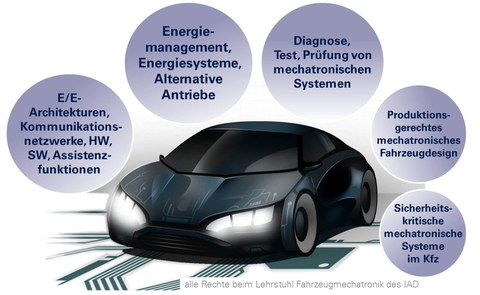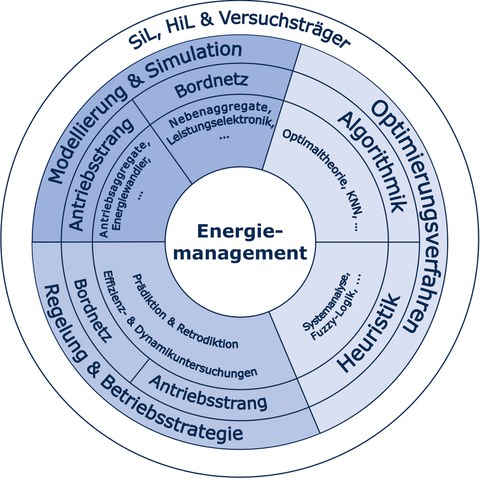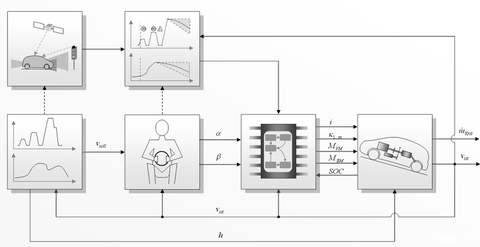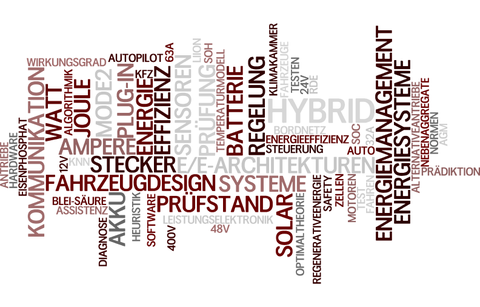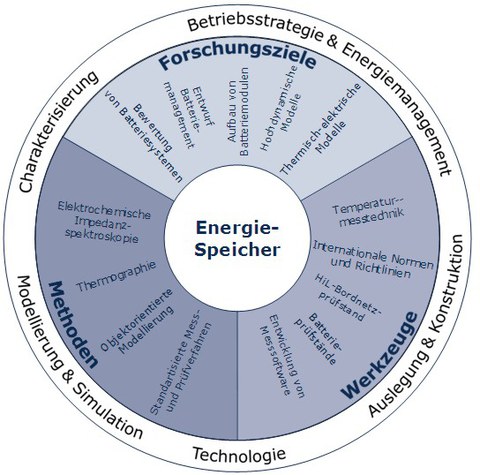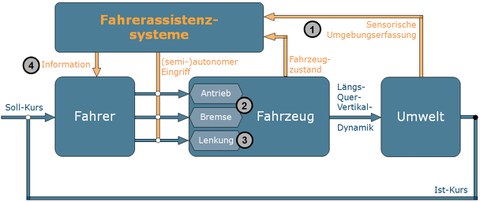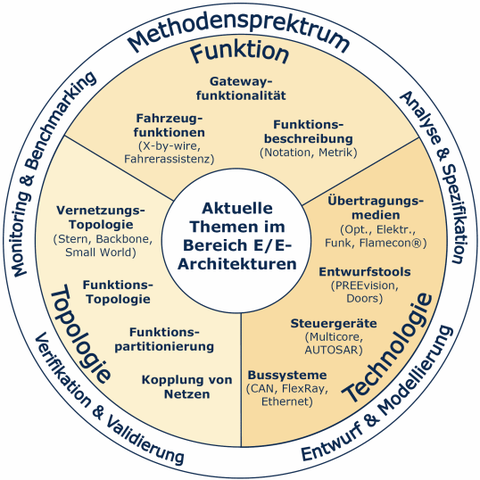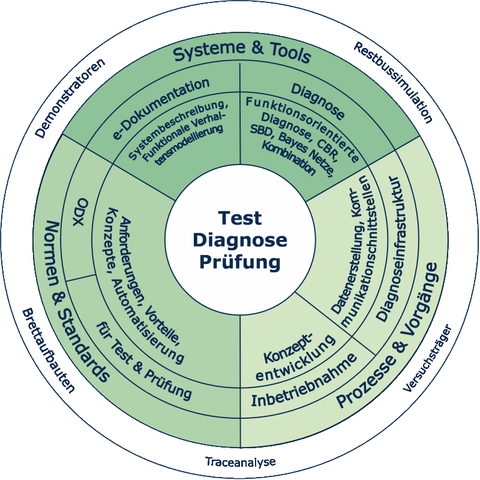Research Areas
In automotive engineering, the term “energy management” describes all measures which ensure adequate, safe and efficient energy supply. This comprises topics like efficient route selection, optimisation of the quality of driving and optimisation of operational strategies. One can distinguish between bord power/energy management and traction energy management.
The latter in particular takes on greater significance when it comes to electrified drive trains in order to optimally use the potential of reducing consumption. The selection of the most suitable mode of operation and the control of the drive train is done by the operational strategy.
A prognosis and information on the future route can reduce fuel consumption with the help of an optimised operational strategy.
In the depiction below, a hybrid car with a predictive operational strategy is shown which realises the driver’s wish for acceleration or deceleration by controlling the vehicle. Further information on the future route of the drive is helpful. Information can be generated by data fusion of prior vehicle motion, maps or sensors inside the car (which can then be used to predict future road behaviour and control the vehicle adequately).
In order to evaluate this system, standardised driving cycles as well as actually metered driving profiles are used (which the driver follows via operating the brake pedal for example).
Electrical energy storage (batteries, supercapacitors) find a wide range of application in daily life, be it the torch, the mobile phone or the laptop. Due to increasing electrification of various components of the motor vehicle, energy storage has become a key technology.
Research is aimed at developing a proper understanding of the different battery technologies and their macroscopic behaviour, thus facilitating safe and efficient use of them in the vehicle. An essential part of that is the metrological investigation of batteries and their modelling.
| Topics | |
|---|---|
| Storage technologies |
|
|
Characteristics of batteries: |
|
| Designing of battery systems used in laboratories |
|
|
Modelling and simulation: |
|
Another thematic focal point at the Chair of Automotive Mechatronics is the field of driver assistance systems – primary safety – automated driving. The depiction below shows how driver assistance systems work (using the control loop driver-vehicle-environment). The individual spheres of competence include the following research objectives: (1) sensory data gathering of the environment, (2) drive trains, (3) steering, (4) information. They can be seen in the depiction and are described in the table below.
The following table briefly explains the four thematic focal points and research objectives of the Chair in the field of driver assistance systems.
| Topic | Description |
| (1) |
Sensory signal processing/data fusion of vehicle environment sensors metrological assessment/evaluation of environment sensors with the help of an adequate measurement setup in the IADvehicle test site in Dresden-Nickern |
| (2) | Predictive vehicle control ((2a) energetically optimised longitudinal guiding, (2b) primary safety/accident prevention) on the basis of information onthe environment around the vehicle |
| (3) |
Design and prototypical demonstration of the procedure of path planning for automated lateral vehicle dynamics |
| (4) | Prototypical design of visualisation and control concepts for driver assistance |
A team of students at Dresden University of Technology (called “I-Speed”) participated in the Carola Cup (design of automated model vehicles) in February 2009. They got third place in the prize competition.
The transition of the motor vehicle from a purely mechanical to a mechatronic system accompanied by the ever-increasing complexity of the systems incorporated in cars requires novel architecture concepts. The objective is to design complex and heterogeneous vehicle systems conforming to the specifications of pre-designed architecture (regarding aspects like function, topology, technology and design). The research objectives in the field of E/E architectures are in line with that.
An E/E architecture is a generic concept which describes the functional, topological and technological aspects of the E/E systems of the vehicle, the design of the systems and how they are connected. Today’s E/E architectures become increasingly more complex, more various in their versions and integrate innovative technologies. An attempt at mastering the complexity is made by describing the architecture aspects and by applying self-organising features of the vehicle (federative architecture).
| Function |
|---|
| The functional aspect of an E/E architecture describes the required behaviour of the E/E systems in the form of functions. This allows for a formal description of the behaviour as a composition of various functions. The functions are realised with the help of both hardware and software, and are then mapped onto a network of control units. |
| Topology |
|---|
| The topological aspect of an E/E architecture describes the assembly of the control units and the infrastructure inside the vehicle: their spatial arrangement in the vehicle, on the one hand, and on the other, their logical arrangement (which can be looked at independently from the spatial arrangement). |
| Technology |
|---|
| The technological aspect of an E/E architecture considers the vital resources needed in order to construct the requested E/E system, e.g. the control units used, the infrastructure of both communication and energy supply as well as programming languages, protocols and operating systems. |
| Design |
|---|
| The design process of an E/E system consists of several phases, e.g. analysis, specification, design of the components, and trial. The arrangement of those phases is described in design models. Such a design model is an essential part of an E/E architecture; it assists the developer and ensures a high level of quality. |
… guarantee the system integrity of E/E systems (functional, topological, technological and procedural aspects) over their life cycle using diagnostics infrastructures.
Testing:
examination of a technical system for its compliance with the specifications and pre-selected functionalities (via selective tests)
Prüfung:
Untersuchung eines technischen Systems auf Einhaltung ausgewählter Funktionalitäten mittels selektiver Tests.
Diagnosis:
analysis of a system in order to find the cause of a problem and to assess undefined and unexpected system behaviour with the aid of testing processes as well as inspection and diagnostic procedures

